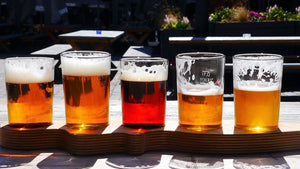

Craft Beer Colors: Beer As Good As it Looks
September 22, 2017
Craft beer makes three first impressions: first with its name, second with its style, and third with its color. Of these impressions, color is what’s most critical to success. Every beer, as the saying goes, never has a second chance at making a first impression (or three). For craft beers in particular, the way a beer looks is incredibly important because it not only influences its flavor, but its appearance tells your taste buds what to expect. Indeed, there are brewers who—like fantastical wizards atop beer mountains capped with frothy, cascading foam—can trick the eye and consequently the senses, but more often than not, what you see is what you get. We're human, after all, and our senses can’t help but influence one another. But, the color of a beer can illustrate the delicacies within and mastery of the brewing process. In other words, veteran beer drinkers can determine the quality of a brew simply by relating its style to its color. So what determines a beer’s color? There’s a mix of technical and mathematical jargon to discern, but for the sake of simplicity, the color of beer can be predicted by considering the color and quantity of the malts used. Meanwhile, color intensity is measured and referenced using the SRM (Standard Reference Method) scale, which was endorsed by the American Society of Brewing Chemists in the early ‘50s as the standard way to communicate beer color. While there are plenty of beer styles and colors, we’ve plucked out a select few to help get you started on your way toward impressing everyone at the bar. It’s worth remembering, however, that nothing in the world of craft beer is definite; every day new brews are being worked on that defy expectation—for better or worse. This chart is but a guideline on your beer journey, we leave the tasting and decision making up to you! 

